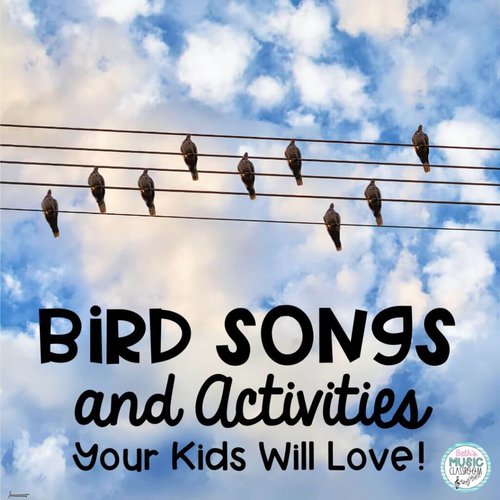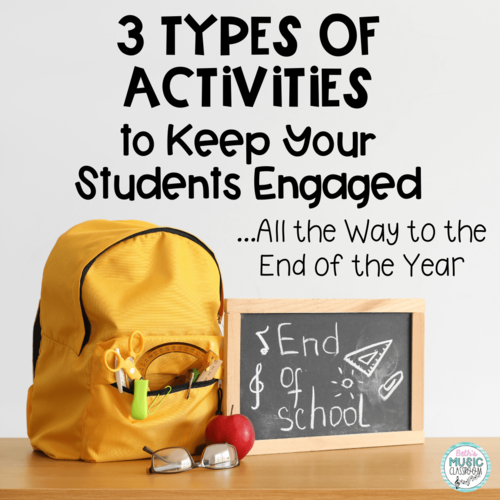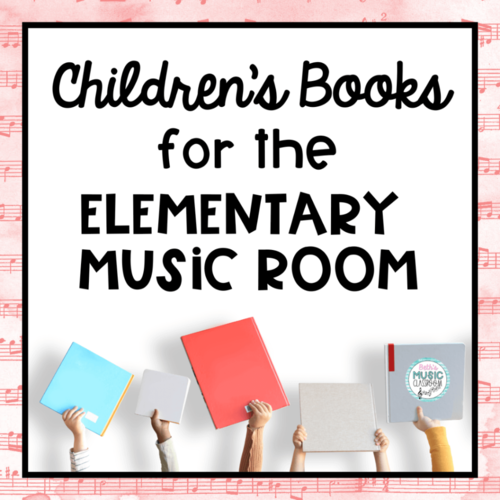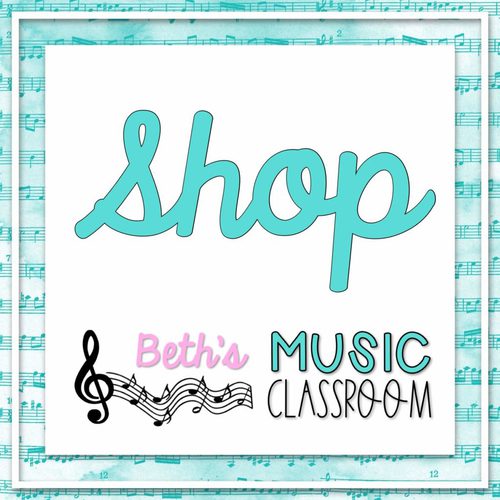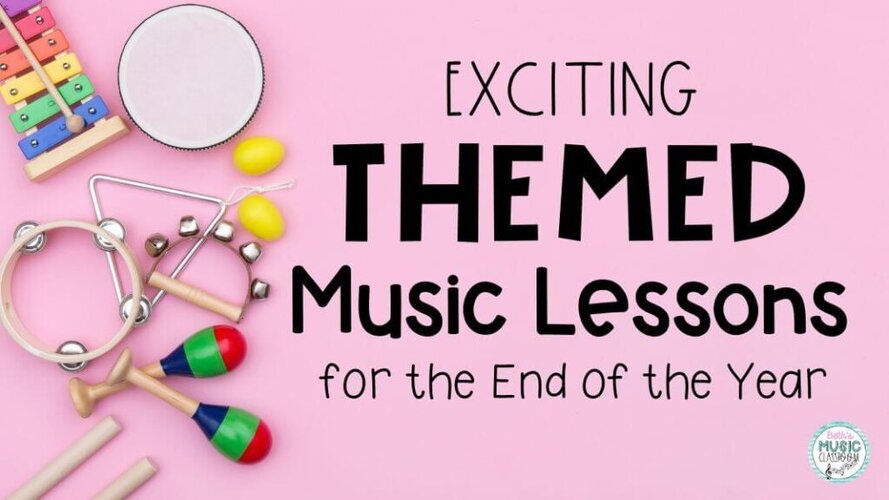
The end of the year in the music room can be a bit chaotic—but also a lot of fun. Kids are squirrely, dreaming of summer, and ready to check out. The good news? You’ve taught most of the core concepts already, which means you can review everything with a creative spin. That’s why I love using an exciting themed lesson at the end-of-the-year.
Using a fun theme keeps your class focused, gives your lesson structure, and makes things memorable—without needing to introduce brand-new content. Whether it’s carnival, ice cream, or transportation, a well-planned theme can keep kids learning (and moving!) right up to the last day. These themed lessons are a great way to wrap up your end-o-the-year music plans with energy and engagement.
Want to give them a tray with your own students? I’m going to walk you through each and every step that I take when planning my themed lessons. Let’s dive in!
Step 1: Choose a Lesson Theme
First, start by choosing a theme for your lesson—one that will excite your students. It does not need to be tied init to a holiday or season. Just pick something fun and easy to build activities around.
Think about the age/grade and ability of your students. Also, consider the time frame you will have for the lesson. Here are a few that I’ve used in the past:
- Animals
- Colors
- Farm
- Bugs & Insects
- Fishing
- Dinosaurs
- Traveling/Vacation
- Space
- Construction
- Camp
- Amusement Park/Carnival
- Circus
- Ice Cream
- Western
- Picnic
- Pirates
- Ocean
- Fairy Tales
- Gardening
- Superhero
- Sports/Olympics
Step 2: Choose a Format
Next, think about the format or structure for your themed lesson. This will help you think through how you will present it to your students, depending on your teaching style and classroom setup.
Landing Page
The first option is to use a landing page, which is just my term for a digital menu or board with clickable links to each activity. This is just a term that I use because it helps describe how flexible this format can be—it allows you to easily choose the order of activities based on your class’s needs and how much time you have.
I actually use a landing page every day in my classroom for my opening slides, and I just swap out the background and links for each new cycle I teach. I have each grade level with a list of all activities and links they will be using. It keeps things simple—I only need one tab open because everything else is linked right on that main Google Slides presentation. It is also fantastic to use for a substitute lesson.
Virtual Field Trip
Another popular format for a themed lesson is a virtual field trip, where students use a computer and their imagination to take part in a themed journey, with activities embedded along the way. You can base these on any topic, and they work especially well for the end of the year because they often include a variety of themed activities and a review of different concepts. You can use virtual field trips as a whole-class experience, in small groups, or even at centers with different themes in each station.
Book-Based Lesson
Finally, you might choose a book-based lesson. This format centers around a children’s book, with themed activities that branch out from the story. You can choose to build an Orff arrangement, create movement activities, compose a sound story, or even all of the above. Small group work also works great with this format—each deciding what to add to their assigned part of the story. After time for students to plan and practice their part, then read the book with all of the music activities added into it.
Step 3: Choose the Activities
Now that you’ve decided on your lesson theme and format, you’re ready to choose the specific activities.
Search through your song collection, music magazines, and student curriculum that you already own. Search online for any brand new songs and activities to fill in the gaps. Just remember to keep your lesson theme in mind.
Rhythmic and Melodic Practice
Rhythm and melodic practice can be a fun and easy way to reinforce skills during themed lessons. You can use matching games, write-the-room activities, or interactive digital slides to keep things engaging. Whether students are working together at the Smart Board, using Chromebooks in small groups, or completing a rhythmic activity on their own, the key is to keep the focus on review while still making it feel like play.
Movement and Dance Activities
Movement is another great area to get creative with your theme. You can stick with tried-and-true favorites like body percussion, freeze dance, scarf activities, or parachute games—or you can create movement that connects directly to your theme. For example, in a farm themed lesson for K–1st, students might strut like a rooster, gallop like a horse, or tiptoe through a pretend chicken coop. For a carnival themed lesson, create a parachute activity to use with carnival themed music. Add motions like a ferris wheel (walking around in a circle) or a rollercoaster (moving up and down). Adding movement keeps energy high and students engaged.
Singing
Singing activities are a natural fit for any themed lesson. You can keep things simple with ones your students already know and love—just tie them into the theme with a quick intro or story. You can also search for new folk or kid’s songs that match your theme. For example, in a color-themed lesson, add in songs like “De Colores,” “Purple Stew,” or “Colors” by Hap Palmer.
Composing
Composition activities are also a wonderful addition to your themed lessons. Rhythmic composition is great for younger students, and you can adapt it for any theme. Using rhythmic building blocks, each student or group can compose their own 8 or 16-beat themed composition. You can try the same with melodic composing or incorporate your theme a bit more. For example, ask students to create a melody that sounds like you’re riding a rollercoaster or just scored a goal.
Music Theory
Music theory review is another option for themed lessons. Students will enjoy out-of-their-seat games and activities way more than worksheets or just listening to the teacher. Here’s some examples: use a race car theme to review tempo terms and their meanings or try a virtual safari trip to review dynamics of different animals. These will keep music theory practice fun, relevant, and easy to manage at the end of the year.
There are plenty more activities you can try beyond the ones I’ve listed here. Don’t be afraid to get creative and explore even more ideas that fit your theme!
Step 4: Differentiate as Needed
The fourth step in planning themed lessons for your music room is to differentiate. Decide if you’d like to use the same theme for multiple grades (which I would suggest). Then determine how you can differentiate for each grade level. Also, consider how you may need to adjust the activities based on various student needs. Think about:
- How to adapt themed activities for each grade level
- Instrument or movement options for students with limited mobility
- Simplified alternatives for more difficult activities
- Which activities focus on visual, auditory, and kinesthetic learners
- If any activities will need an alternate version for students with diverse needs
Final Tips for Your Themed Lessons
Once you’ve got everything planned, here are a few tips to make sure the lesson runs smoothly in the classroom:
- Test your tech: Test any digital slides, audio clips, or interactive links ahead of time so you’re not troubleshooting in front of the class.
- Have everything ready: Gather any props, instruments, or visuals before students arrive, so transitions are quick and smooth.
- Set clear expectations: Before starting, remind students of the expectations and any unique rules for this special lesson.
- Set the tone right away. Introduce the theme with a quick story, song, or visual. Jump right into a high-energy activity to grab their attention and get them engaged right away.
- Use storytelling to connect the pieces. Frame the lesson like an adventure—each activity can be a new “stop” or “challenge” that leads to the next one.
- Alternate between high- and low-energy tasks. Start with a movement or singing game, then follow it with a less active rhythm or composition activity. This keeps the energy balanced.
- Be flexible. The end of the year can be unpredictable, so have backup activities ready, and don’t stress if your lesson doesn’t go exactly as planned.
- Reflect and adjust: After the lesson, take a minute to jot down what worked well and what you’d adjust next time—especially helpful if you plan to reuse your theme in the future.
Conclusion
Using themed lessons in music class are one of the best ways to make your end-of-the-year music time stress-free and fun. You get to reinforce learning while giving students an exciting lesson. With a little planning, you’ll finish the school year strong—and your students will leave music class smiling.
Lesson planning can eat up hours you don’t have—especially as the school year wraps up. I have lots of themed music lessons to help you jump right in, keep your K-3rd graders engaged, and save you tons of prep time. Just browse the different themes below that I have available in my TpT store. and you’ll find all types of activities for themed lessons.
- Animals
- Traveling/Vacation
- Construction
- Carnival
- Ice Cream
- Western
- Pirates
- Gardening
- Superhero
- Sports
Well, what’s your favorite lesson theme to do with your students? Leave a comment below or send me an email at beth@bethsmusicclassroom.com. I’d love to hear from you!

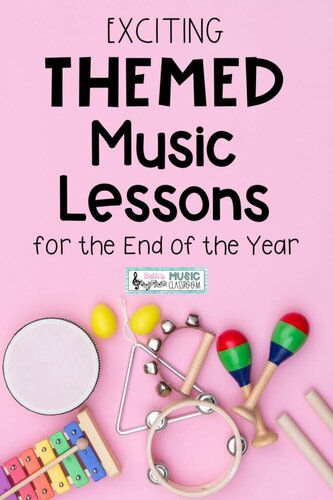
Here’s some other posts you may like.
